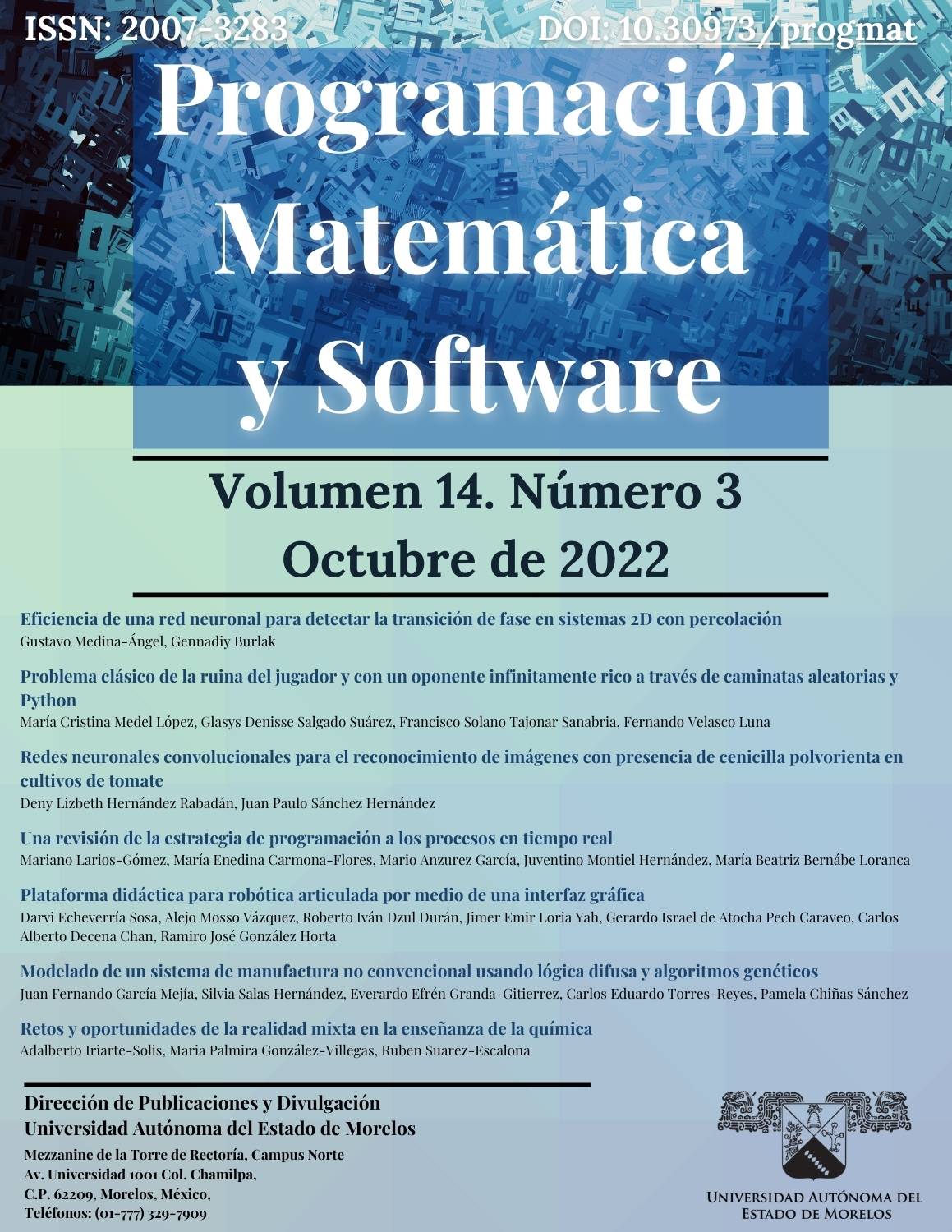Challenges and opportunities of mixed reality in teaching and learning chemistry
DOI:
https://doi.org/10.30973/progmat/2022.14.3/7Keywords:
Mixed reality, chemistry education, virtual reality, chemistry laboratoryAbstract
Mixed reality is a key technology for the jobs of the future. The objective of this work is to study the contribution of mixed reality in the teaching of chemistry. A systematic literature review (SRS) was used as a strategy to identify the most relevant studies, based on the one proposed by Higgins and Green. The literature was organized into three categories: Chemistry laboratories with augmented reality, with virtual reality and with mixed reality. The main augmented reality applications found were Chemist, QuimicAR, AR Lab and BiochemAR. Regarding virtual reality applications, they were Nanome, HoloLAB Champions, vLUME and ProteinVr. Only two mixed reality laboratories were found which are Narupa and the Mixed Reality Chemistry Laboratory developed by DUAN. The general benefits mentioned by the reviewed works were to provide security when performing a task without any risk, access remotely from anywhere, have realistic scenarios, provide innovative and pleasant scenarios to simulate chemical experiments and allow different learning modes in experiments chemistry, making learning fun and interesting. However, there are several main problems and limitations, including dizziness and lack of orientation, as well as the poor accessibility of devices capable of reproducing these technologies. But the digital educational resources developed with these technologies incorporate interactive and multimedia content that favor attention, motivation and enrich the learning experience of students.
References
MAAS, M. J.; HUGHES, Janette M. Virtual, augmented and mixed reality in K–12 education: A review of the literature. Technology, Pedagogy and Education, 2020, vol. 29, no 2, p. 231-249. https://doi.org/10.1080/1475939X.2020.1737210
MILGRAM, Paul; KISHINO, Fumio. A taxonomy of mixed reality visual displays. IEICE TRANSACTIONS on Information and Systems, 1994, vol. 77, no 12, p. 1321-1329.
DUAN, Xiaoyun, et al. Mixed Reality System for Virtual Chemistry Lab. KSII Transactions on Internet and Information Systems (TIIS), 2020, vol. 14, no 4, p. 1673-1688. http://dx.doi.org/10.3837/tiis.2020.04.014
R. Schalkoff, Pattern Recognition: statistical, structural and neural approaches. John Wiley & Sons, Inc., 1992. https://doi.org/10.1142/3641
ERIKSEN, Kristina; NIELSEN, Bjarne E.; PITTELKOW, Michael. Visualizing 3D molecular structures using an augmented reality app. 2020. https://doi.org/10.1021/acs.jchemed.9b01033
GRANDO, John Wesley; DAS GRAÇAS CLEOPHAS, Maria. Aprendizagem Móvel no Ensino de Química: apontamentos sobre a Realidade Aumentada, 2020. http://dx.doi.org/10.21577/0104-8899.20160236
DA SILVA, Bruno Rogério, et al. Ar lab: Augmented reality app for chemistry education. En Nuevas Ideas en Informática Educativa. Proceedings of the International Congress of Educational Informatics, Arequipa, Peru. 2019. p. 71-77. https://doi.org/10.1145/3306307.3328180
SUNG, Rou-Jia, et al. BiochemAR: An augmented reality educational tool for teaching macromolecular structure and function. Journal of Chemical Education, 2019, vol. 97, no 1, p. 147-153. https://ui.adsabs.harvard.edu/link_gateway/2020JChEd..97..147S/doi:10.1021/acs.jchemed.8b00691
RAMÍREZ, Jorge Álvarez; BUENO, Ana María Villarreal. Learning organic chemistry with virtual reality. En 2020 IEEE International Conference on Engineering Veracruz (ICEV). IEEE, 2020. p. 1-4. https://doi.org/10.1109/ICEV50249.2020.9289672
WINTER, Julia. Playing with chemistry. Nature Reviews Chemistry, 2018, vol. 2, no 5, p. 4-5. https://doi.org/10.1038/s41570-018-0006-x
SPARK, Alexander, et al. vLUME: 3D virtual reality for single-molecule localization microscopy. Nature Methods, 2020, vol. 17, no 11, p. 1097-1099. https://doi.org/10.1038/s41592-020-0962-1
CASSIDY, Kevin C., et al. ProteinVR: Web-based molecular visualization in virtual reality. PLoS computational biology, 2020, vol. 16, no 3, p. e1007747. https://doi.org/10.1371/journal.pcbi.1007747
O’CONNOR, Michael B., et al. Interactive molecular dynamics in virtual reality from quantum chemistry to drug binding: An open-source multi-person framework. The Journal of chemical physics, 2019, vol. 150, no 22, p. 220901. https://doi.org/10.1063/1.5092590
DUAN, Xiaoyun, et al. Mixed Reality System for Virtual Chemistry Lab. KSII Transactions on Internet and Information Systems (TIIS), 2020, vol. 14, no 4, p. 1673-1688. https://doi.org/10.3837/tiis.2020.04.014
Downloads
Published
How to Cite
Issue
Section
License
Copyright (c) 2022 Adalberto Iriarte-Solis, Maria Palmira González-Villegas, Ruben Suarez-Escalona

This work is licensed under a Creative Commons Attribution 4.0 International License.
Usted es libre de:
 |
Compartir — compartir y redistribuir el material publicado en cualquier medio o formato. |
 |
Adaptar — combinar, transformar y construir sobre el material para cualquier propósito, incluso comercialmente. |
Bajo las siguientes condiciones:
 |
Atribución — Debe otorgar el crédito correspondiente, proporcionar un enlace a la licencia e indicar si se realizaron cambios. Puede hacerlo de cualquier manera razonable, pero de ninguna manera que sugiera que el licenciador lo respalda a usted o a su uso. |
| Sin restricciones adicionales: no puede aplicar términos legales o medidas tecnológicas que restrinjan legalmente a otros a hacer cualquier cosa que permita la licencia. |










